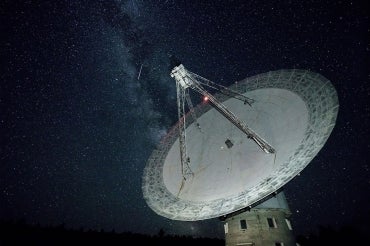Unlocking the mystery of Fast Radio Bursts: U of T astronomers

Published: March 21, 2018
A researcher from University of Toronto and her team are using the supercomputers at SOSCIP to investigate the nature and origin of a strange but beautiful phenomenon called Fast Radio Bursts.
Known as FRBs, the rapid, intense and very bright bursts of light last fractions of a second in duration. But they have made a lasting impression on astronomers and have raised vast questions about their origin.
“FRBs are strange objects that don’t make sense. We want to use advanced computing to better understand them,” said Renée Hlozek, an assistant professor with the Dunlap Institute for Astronomy & Astrophysics, in U of T's department of astronomy and astrophysics. “It’s surprising because the FRBs are distributed all over the sky, and have surprising characteristics that point to new physics we don’t understand.”
The explanation for these rapid bright bursts ranges anywhere from wildly speculative suggestion of alien signals, to the more astrophysical but still extreme suggestions of collisions between dense objects like black holes or flares on magnetars.
Working closely with Hlozek is Tina Peters, a postdoctoral fellow at the Dunlap Institute and a SOSCIP TalentEdge Postdoctoral Fellow.
Read more about SOSCIP
The female-led team will apply machine learning techniques to help classify and understand FRBs with data collected from the Algonquin Radio Observatory (ARO), Canada’s largest fully-steerable radio telescope at a massive 46 meters in diameter.
They are supported by industry partner Thoth Technology Inc., a Canadian space and defense company which provides Space Situational Awareness services at ARO and supports astronomical research.
“U of T’s work on FRBs is a very exciting new field. And one that has really captured the public imagination,” said Caroline Roberts, CEO and President of Thoth, which she co-founded in 2001. Both Roberts, from Newfoundland, and Hlozek, from South Africa, are Rhodes Scholars.
This is not Thoth Technology’s first collaboration with SOSCIP or U of T. Thoth Technology has collaborated on several SOSCIP R&D projects with U of T faculty, Ue-Li Pen, Keith Vanderlinde and Marten Van Kerkwijk.
“We have a very active astronomy program with U of T,” explains Roberts.
Previous projects include building innovative technologies to create virtual, real-time VLBI techniques. VLBI, or very long baseline interferometry, involves using large telescopes located in different geographic locations to create a much larger and powerful radio telescope.
Read more about Pen’s project
“It’s a wonderful opportunity to work with U of T researchers. As a company, we have access to a highly skilled and educated pool of graduate students and postdocs that we hope to hire from. There are so many advantages for a company like ours to work on these innovative collaborative projects,” said Roberts.
“One of the great things about the support from SOSCIP, IBM Canada and FedDev Ontario is the really incredible connections. As a person new to Canada, it’s unique to see an initiative like SOSCIP which aims to combine industry and academia to facilitate connections and build a collaborative community,” said Hlozek. “It can be easy as a researcher to get stuck in the rut of doing the same work you’ve done before and using the same skills. But this type of collaboration and level of support allows a little bit of risk-taking to take place – you can think in new areas and engage in new partnerships.”
“I’m meeting in the middle with skills I have in machine learning and learning new skills with the data that is provided by ARO,” explains Peters. “This is an exciting mystery to try and solve, and there’s definitely new knowledge to be learned about the universe.”
The team is aiming to develop a proven methodology by summer 2018.
“It’s a little blue sky, but there is a lot of reward in unravelling the mystery,” said Hlozek.



